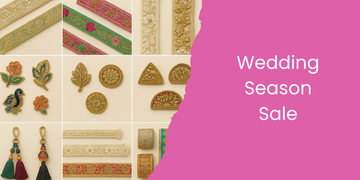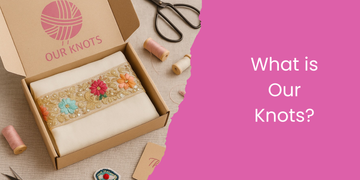Gota Patti, also known as "gold ribbon work," is a form of applique embroidery that uses metallic ribbons or zari to decorate fabric. The origins of Gota Patti can be traced back to the royal courts of Rajasthan, especially in cities like Jaipur, Udaipur, and Jodhpur. It is believed that the technique was brought to India by Persian and Mughal artisans, who were already using metallic threads to embellish garments.
The name "Gota" refers to the metallic zari ribbons that are used in the work, while "Patti" means "strip" or "ribbon" in Hindi. The art of Gota Patti embroidery was initially used to adorn the royal attire, wedding garments, and ceremonial outfits. The rich gold and silver threads added a regal and luxurious touch to the fabrics, making it a favorite for the elite class.
Over the years, this technique found its place in traditional wear for weddings and festivals, becoming a vital part of Rajasthani culture. Today, Gota Patti is not only a staple in bridal lehengas and sarees but also in fashion collections and couture designs across India.
The Origin and History of Gota Patti
Gota Patti embroidery is an exquisite form of embellishment that has become synonymous with luxury and tradition in Indian fashion. Originating in Rajasthan, it remains a popular choice for brides, designers, and boutique owners due to its intricate patterns, vibrant shine, and rich cultural history. This traditional art form continues to captivate and inspire modern fashion with its striking visual appeal. Let’s dive into the fascinating world of Gota Patti, its origins, techniques, and how it has evolved over the years.
Rajasthan is undoubtedly the home of Gota Patti, and cities like Jaipur, Udaipur, and Ajmer are particularly famous for producing high-quality Gota Patti work. Jaipur, in particular, is known for its centuries-old tradition of Gota Patti, with local artisans passing down their craft from generation to generation. The city remains a hub for Gota Patti work, with many boutique owners and designers sourcing materials from this region to create luxurious wedding attire, festive wear, and even modern fashion collections.
Apart from Rajasthan, other states have adopted this beautiful art form, but it’s the rich cultural and royal history of Rajasthan that gives Gota Patti its distinctive charm. The combination of Rajasthan’s rich history, skilled artisans, and the intricate detailing of Gota Patti makes it a staple in bridal couture and luxury fashion across India.
Each of these traditions, along with Gota Patti, contributes to Rajasthan's rich and diverse embroidery culture, which continues to thrive today.
The Different Types of Gota Patti Work
Gota Patti work has evolved and adapted to modern tastes, with various types and techniques of stitching being used. The art form now includes a variety of styles that cater to different tastes, from traditional to contemporary. Some of the most popular types of Gota Patti work include:
-
Gota Patti Applique:

This is the traditional form of Gota Patti work, where metallic ribbons are cut into different shapes such as flowers, leaves, and motifs, and sewn onto fabric to create a shimmering, textured effect. -
Zardozi and Gota Patti:

A more intricate variation, this technique combines the elegance of Zardozi (metallic thread embroidery) with Gota Patti, adding extra layers of luxury and detailing to the work. -
Cutwork Gota Patti:

This variation involves cutting the fabric to create patterns and then applying the metallic ribbons of Gota Patti to highlight the cut areas, adding more depth and dimension to the design. -
Gota Patti with Beads and Stones:

Modern interpretations of Gota Patti often include the addition of beads, sequins, and stones to the traditional design, making the embroidery even more eye-catching and glamorous.
The Process of Creating Gota Patti Work
Creating Gota Patti embroidery is a labor-intensive process that requires skill, patience, and precision. It begins with selecting the fabric, which can be anything from silk, georgette, or satin to cotton or chiffon, depending on the desired outcome. Once the fabric is chosen, the metallic Gota ribbons are carefully cut into the desired shapes and patterns.
The process involves a few key steps:
- Cutting the Gota Ribbons: The metallic ribbons, typically made of zari or thread coated with gold or silver, are carefully cut into various shapes like leaves, flowers, and geometric designs.
- Stitching: The cut ribbons are then sewn onto the fabric using a combination of hand stitches, such as running stitches, back stitches, and French knots. The stitches ensure that the Gota Patti stays in place while enhancing the overall design.
- Adding Embellishments: Once the basic design is complete, additional embellishments like beads, sequins, mirrors, and stones are added to make the design even more stunning. These embellishments add extra sparkle and texture, giving the fabric a luxurious appearance.
- Finishing Touches: The final step is to ensure that the edges are neatly finished, and the overall design is symmetrical and balanced. This meticulous attention to detail is what makes Gota Patti embroidery stand out.
Stitches Used in Gota Patti Work
Gota Patti work requires specific stitches to secure the metallic ribbons onto the fabric and create intricate patterns. Some common stitches used in Gota Patti embroidery include:
- Running Stitch: This is the most basic stitch used to attach the Gota Patti ribbons to the fabric. It is done in a straight line and is the foundation of most Gota Patti designs.
- Back Stitch: A slightly stronger stitch, back stitching is often used to add structure to the design, especially for outlines and detailing.
- French Knots: These decorative knots are used to add texture and dimension to the Gota Patti work. They are often added to the center of flowers or other motifs.
- Chain Stitch: A decorative stitch used to create borders or fill in gaps between motifs, adding depth to the design.
Gota Patti: A Designer’s Dream
For designers and boutique owners, Gota Patti is a treasure trove of possibilities. It allows for endless creativity, blending traditional elegance with modern aesthetics. Gota Patti work adds a touch of grandeur and sophistication to any garment, making it ideal for bridal wear, evening gowns, festive outfits, and even contemporary fashion collections. The versatility of this art form, combined with the ability to add personal touches with different embellishments, makes it a designer’s favorite.
Gota Patti in Modern Fashion
While Gota Patti has deep traditional roots, it has successfully found a place in contemporary fashion. Designers today incorporate Gota Patti embroidery into both ethnic and fusion wear, using it to create modern silhouettes and styles. The combination of traditional techniques with contemporary designs has made Gota Patti a favorite in high-end fashion collections, luxury boutiques, and even ready-to-wear fashion.
Boutique owners and fashion designers often experiment with Gota Patti work by mixing it with other fabrics and techniques, creating a fusion of old and new. The timeless beauty of Gota Patti makes it perfect for high-fashion garments, evening wear, and couture collections.
Conclusion
Gota Patti is not just an embroidery technique; it is a rich tradition that continues to captivate fashion enthusiasts, designers, and boutique owners alike. With its royal origins, intricate designs, and timeless appeal, it remains one of the most sought-after crafts in India, especially for weddings, festivals, and ceremonial wear. The beauty and craftsmanship of Gota Patti embroidery ensure its place as a staple in Indian fashion, promising to add a touch of opulence and elegance to any wardrobe. As this ancient art continues to evolve, it will undoubtedly inspire future generations of designers and fashion lovers worldwide.






